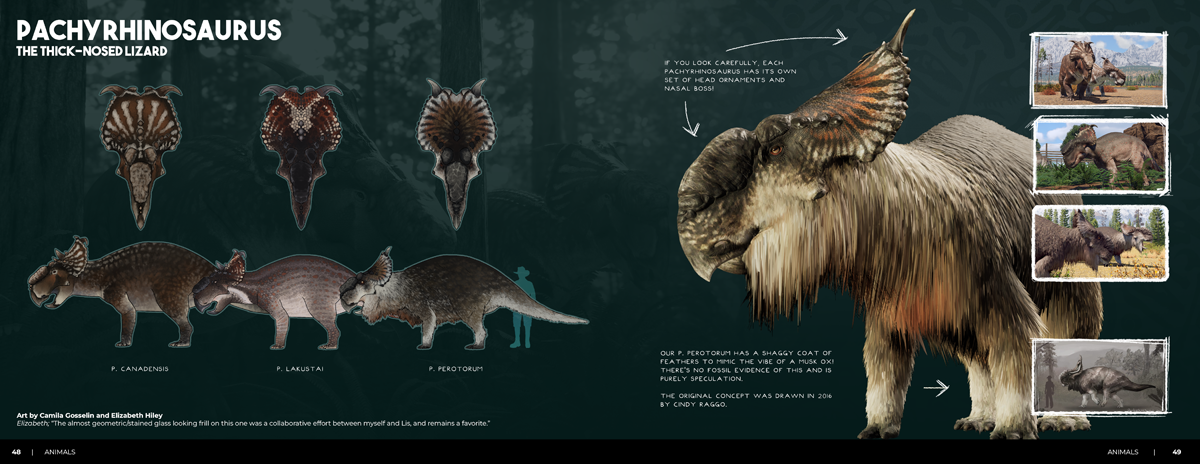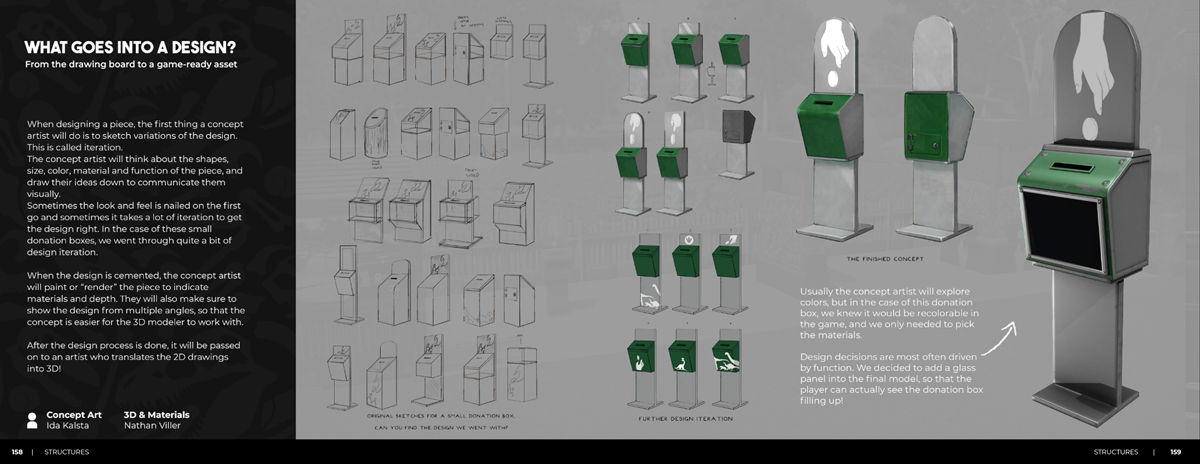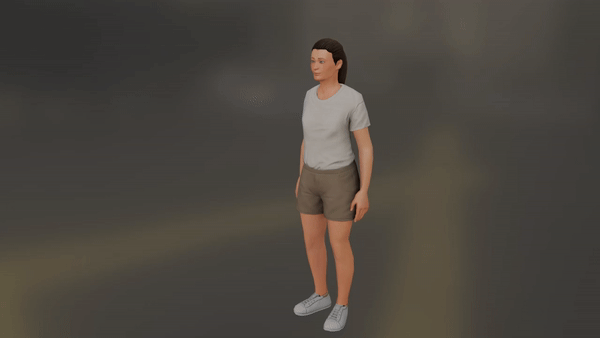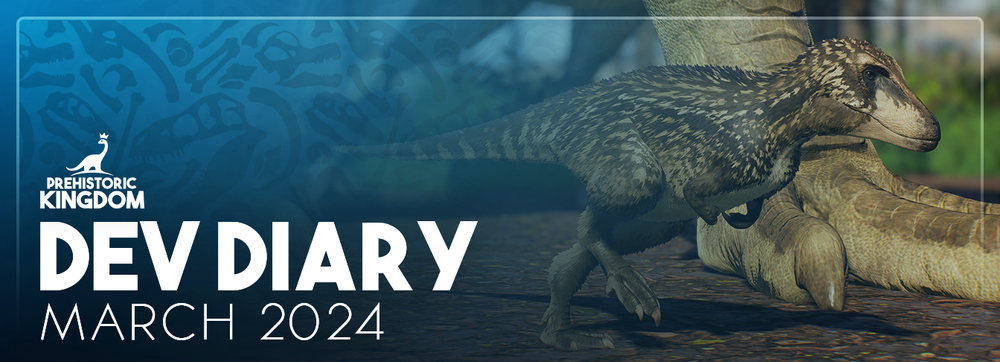
Welcome to the March Development Update!
In this blog post, we’ll be detailing some of the things you can expect to see in Update 11, talking about new game mechanics and more.

Before jumping into the bulk of our Update 11 coverage, we wanted to quickly touch base on a few things.
The first is that we are working on another recording session with the brilliant Nigel Marven! Not only are we doing dialogue for the species that currently lack it, but we’re retroactively adding an introduction and fact to animals that are now an alternate genus (Tarbosaurus, Charonosaurus, etc). It feels strange to say, but soon we’ll have lines for almost every animal that we’re planning to release during Early Access!

Secondly, we’ve revised the American Lion and Cave Lion’s base animations to fix up their thousand-yard stare. We’re not sure what horrors they might’ve experienced, but relaxed cats are on their way in Update 11!

Supporter Bundle
In case you missed it, we dropped the Supporter Bundle in early March to help fund development and provide access to Volume 1 of our digital art book and soundtrack! We are incredibly proud of how these turned out and wanted to thank everyone for their warm reception.
The art book provides a 200 page look at animal concept art, environment renders and concept sheets for the hundreds of building pieces available in-game, whilst offering development insight into our choices and why things were designed that way. It was important for this to feel like it was more than just a picture book!


We also released a soundtrack, featuring 25 minutes of music and 4 exclusive bonus tracks if purchased on Steam or Bandcamp. The album is also now available on streaming, too! You can find the OST on Apple Music, Spotify, YouTube Music and pretty much any other platform you might prefer.
In-Development: Update 11
In late April, we’ll be rolling Update 11 out onto the Public Testing Branch on Steam so that we can gather feedback and continue developing this update. This release is going to massively change how the game is played, so it’s important that we have the community provide feedback during production. So, in the mean time, here’s a broad look at what’s coming soon!
New Species
Update 11 will be introducing two new animals, the first of which is the squirrel-like dinosaur from down under, Leaellynasaura!
(pronounced Lee-ell-in-a-sore-a)

As southern parts of Australia were located within the Antarctic circle during the early Cretaceous, it’s possible that sunlight would have been highly variable. With this animal potentially going weeks without sunlight, we’ve chosen to highlight the various levels of cold tolerance Leaellynasaura might’ve had through varying lengths of plumage per skin.
Unlike the other small, herbivorous dinosaurs in Prehistoric Kingdom, these ones have quite the frightening dentition!


Now, that leaves one unknown species for Update 11, and before anyone rushes to speculation, this is not another theropod. Enjoy!
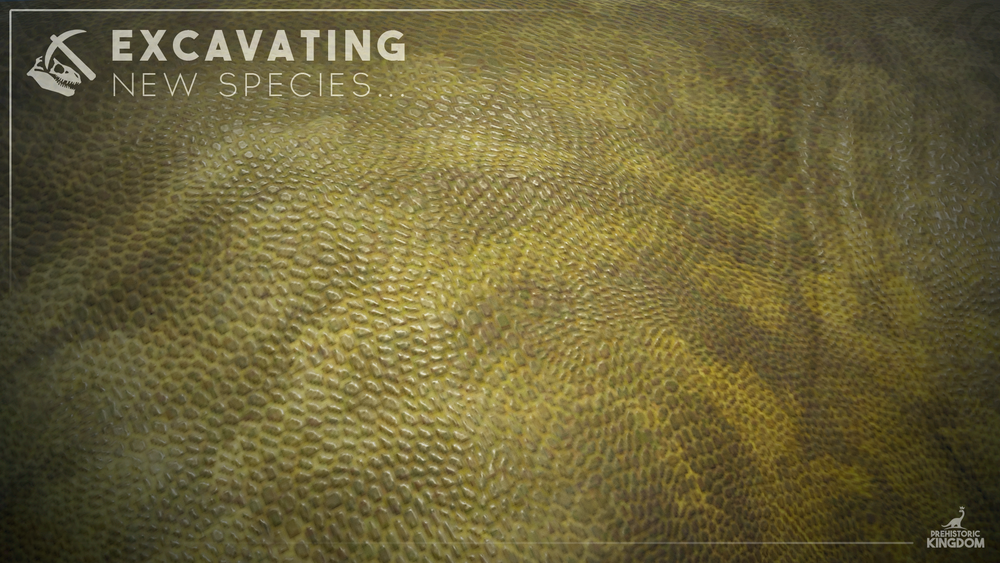
Species Splitting
Going forward into Update 11, all animals in the game will be properly split by their species in the UI. This means that when you’re in the Nursery or Excavations menu, you’ll find distinct buttons for each species, rather than lumping them all under one umbrella. We will be extending this functionality to the Animal Info Signs, too.

As far as the game was concerned, each species was already considered unique, and this change simply makes the UI consistent with that. To reflect this upcoming change, we have updated our website’s Animal Gallery!
The Nursery will be receiving a big UI overhaul down the line to better accommodate these changes, so please stay tuned for that!
Early Staff & Logistics Gameplay
In this part of the Dev Diary, we’re going to walk you through what to expect from logistics and the overall gameplay loop it presents.
When Update 11 releases, we’ll only have keepers and laborers available as they are the most essential at this stage of development. The remaining staff types (janitors, engineers, security, vets) will be added as their gameplay systems become relevant.

STARTING OUT
As you begin to build your park in Update 11, you’ll notice that feeders and kiosks are now empty when placed. In order to actually work, they must be stocked by staff members. This is where our logistics gameplay begins.

To get resources into the zoo, players will first need to build a Loading Bay. Upon the initial first-time placement, players will receive an immediate shipment of goods to help get the park up and running. After that, your Loading Bay will continue to import guest meals, merchandise and a small amount of animal feed every 15 minutes (time not yet finalized) via box truck.
Players can purchase up to 2 additional box trucks for their Loading Bay to speed up delivery times or place additional Loading Bays around the park if they need more shipments.
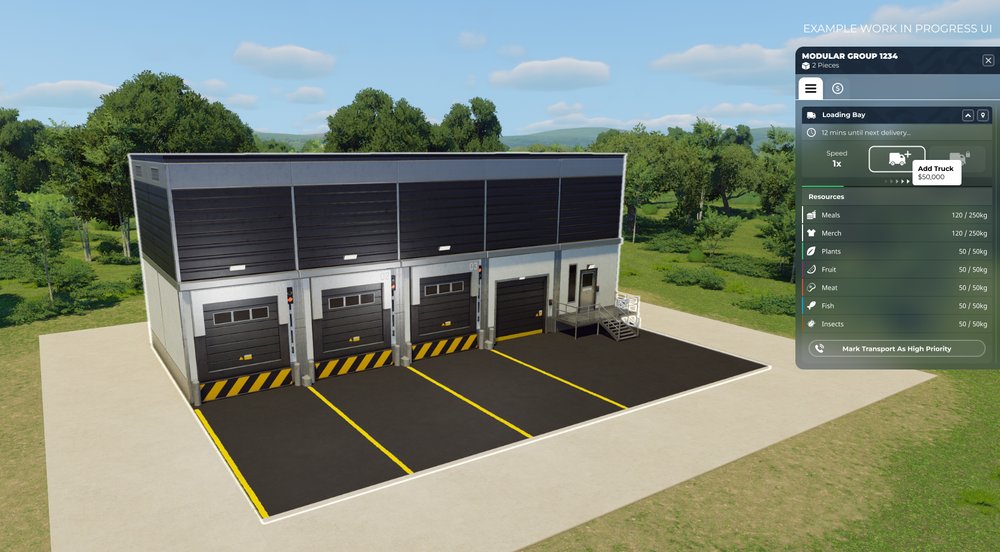
Once the resources have arrived, players will need staff to transport them around the zoo. Laborers can carry the meals and merchandise to guest facilities, while keepers are needed to refill feeders with animal feed.
To access the staff hiring menu, players will need to build a Staff Center. Of course, like any module, these new structures can be built over or recoloured with the modular building system! Just ensure any access points (i.e. doors) remain accessible.


While out in the park, staff are intended to be very automated. You can call staff to complete specific tasks like refilling a certain feeder or transporting goods, but with the scale of Prehistoric Kingdom, the expectation is that they should just do their jobs.
We believe your primary role as park manager should focus on who you hire, how many people you hire and how you layout the park’s logistics infrastructure rather than micromanaging where your staff are and what they are doing. If jobs aren’t being done, you likely don’t have enough people or your layout stinks.
EXPANDING STORAGE
Picture this: you’ve got a few habitats, the zoo is expanding, but so is the distance between your Loading Bay and the park.
It’s time to introduce some Goods Storage and Produce Storage modules! These warehouses come in small or large variants, allowing logistics staff to move stock from the Loading Bay into their respective storage spaces. This means that if a feeder needs refilling or your restaurant needs more meals, staff can simply travel to the nearest storage module that has what they need rather than walking all the way back to the Loading Bay.

These warehouses are planned to have a few basic UI options that dictate how they should be filled up (e.g. stop ‘Fruit’ from being delivered to this Produce Storage module) but we were aiming to make them more contextual, so a Produce Station near a meat feeder is naturally going to have more meat delivered to it than the Produce Station that’s next to a herbivore paddock. That’s all a bit more theoretical, though, just sharing how we’d like them to work.
YOU SMELL THAT?
When animals eat, they eventually… excrete! Without a place to dump their dung, keepers can’t clean habitats. This is why you’ll need to invest in a couple of Compost Heap modules.
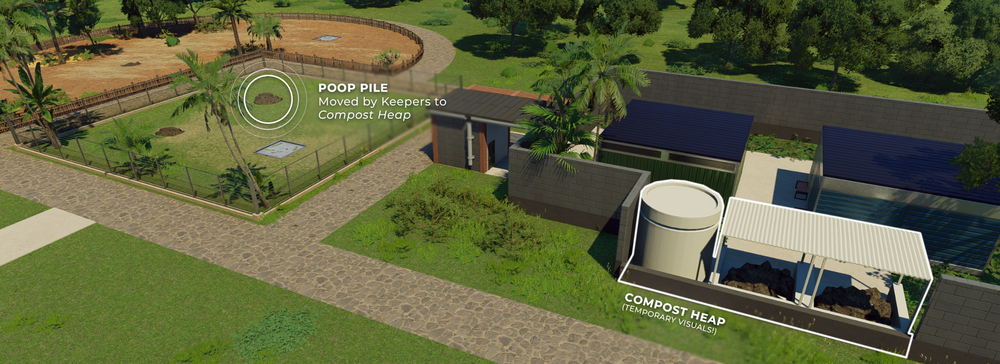

After cleaning dung piles, keepers will transport the poop from a habitat to the nearest Compost Heap. Once delivered, the stored poop will convert to ‘Compost’ over time - a resource that’ll become invaluable when making your own animal feed.
This module can have a pretty negative impact on Park Beauty, so you’ll want to keep it hidden from guest view!
CREATING PRODUCE
After a certain amount of park growth, the measly amount of animal feed you get from the Loading Bay isn’t going to be enough. Thankfully, this is where the Produce Station comes in.
A Produce Station is able to passively create food for your animals by converting the compost in your park into feed. As long as staff can keep delivering compost, you can keep making produce!
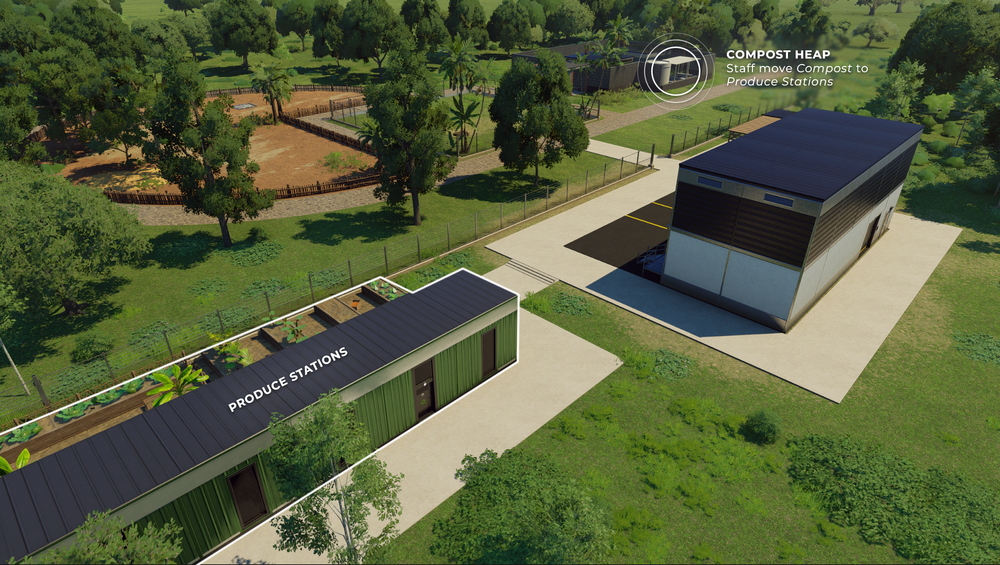
Produce Stations can be specialized to cultivate a specific dietary type (plants, fruit, meat, fish, insects) or produce ALL dietary types for a lower yield per compost conversion. As your Produce Station fills up, laborers will transfer it out and place the feed into the Produce Storage modules around the park.
In the event that you have no storage modules, your Keepers will instead take food directly from Produce Stations when going to refill feeders.

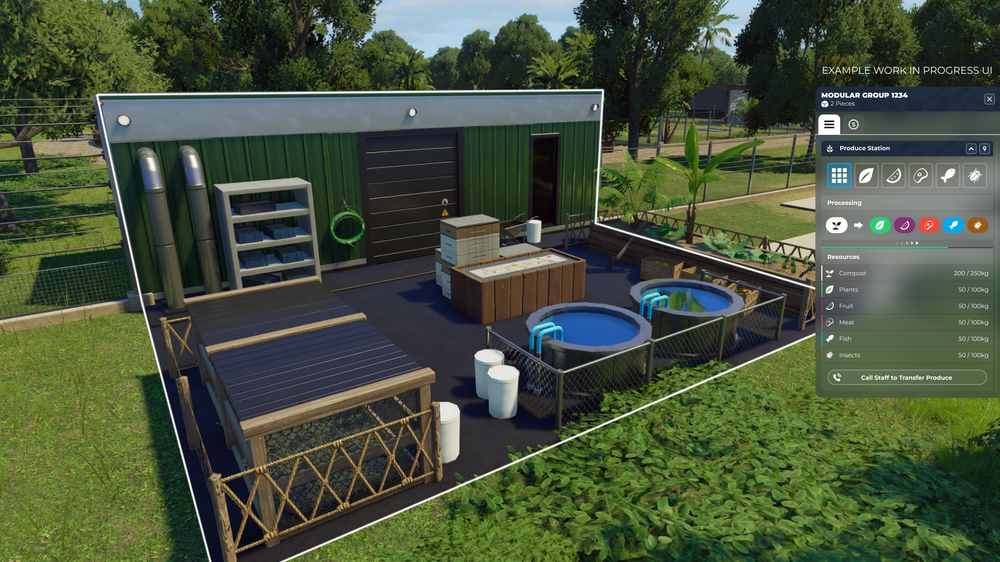
LOGISTICS SYSTEM: IN REVIEW
Looking at everything we’ve just discussed from a very high-level view, we end up with a loop like this!
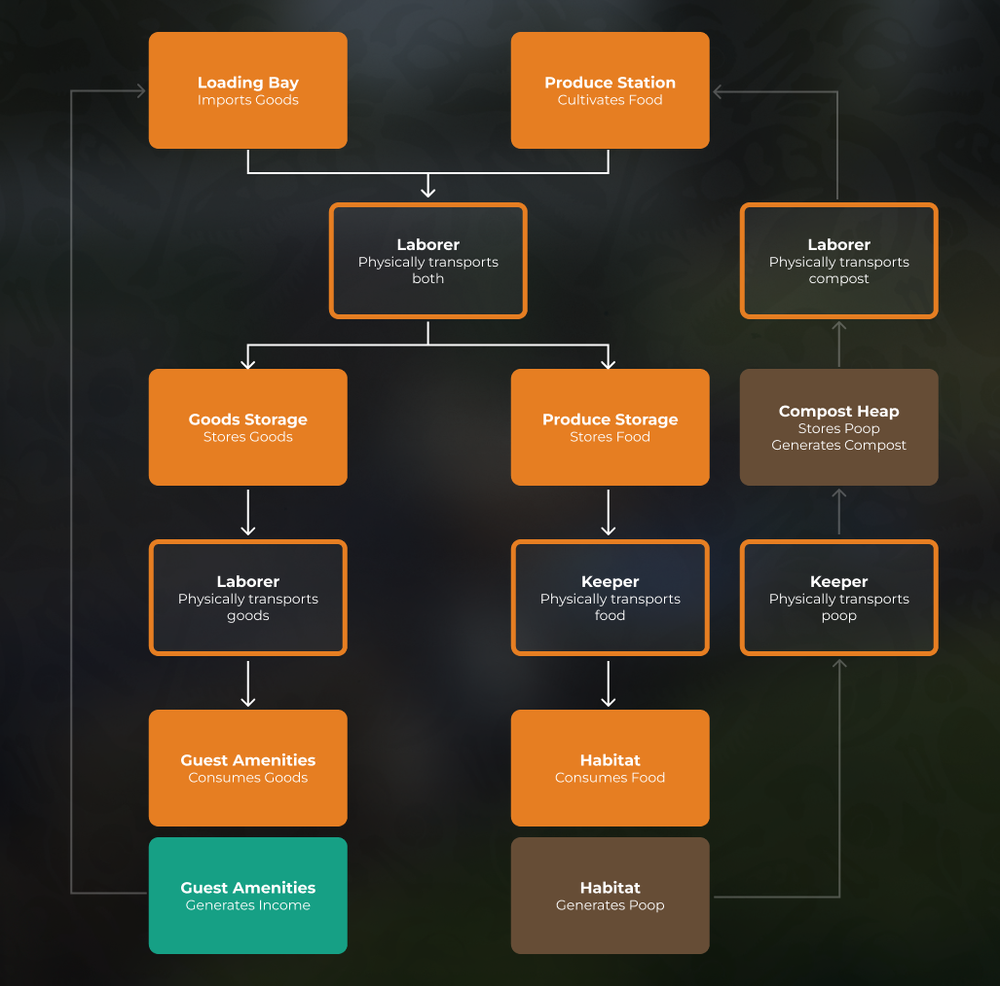
CHANGES FROM JANUARY DEV DIARY
As a final side note, we’d like to mention that since the last Dev Diary, our plans for ‘generalist staff’ have changed. We now intend for cashiers to simply be part of kiosk modules (and their upkeep costs) rather than being separate entities that can be hired/fired like keepers or laborers.
Because of this change, the idea of janitors and laborers temporarily taking on other jobs has been scrapped. This potentially makes the role of staff in the game a lot more clear cut and should make it more obvious when something in the park isn’t working out. Not a huge change in our opinion, but notable enough where we want to keep you in the loop!
Gameplay Changes: Excavations
Excavations are what allows Prehistoric Kingdom to bring extinct animals back to life, scowering the globe in search of viable genetic materials. In the current game, however, the Excavations mechanic really is nothing more than a glorified shopping menu. With Update 11, we aim to rectify this.
THE NEW SYSTEM
Coming in Update 11 is a brand new module - the Fossil Depot! This building provides space for the park’s dig teams and grants access to the Excavations menu.
It is here that players will be able to both buy and send out dig teams to various dig sites around the world. These sites are used to obtain the necessary DNA required to create animals in the Animal Nursery. Any idle dig teams currently not excavating will eventually be visible in the car park below.


(Wikimedia Commons: Hell Creek photograph by Vladimír Socha)
By hovering over a dig site, players will be able to see the potential operating costs of an excavation, the estimated time per excavation cycle and whether or not there are events impacting the dig site. Once opened, up to 5 dig teams can be assigned at once, increasing the ongoing operating costs in exchange for a higher DNA yield every cycle.
There’s no financial penalty for moving teams from dig site to dig site, but they will have to travel back to the park first.
EXCAVATING
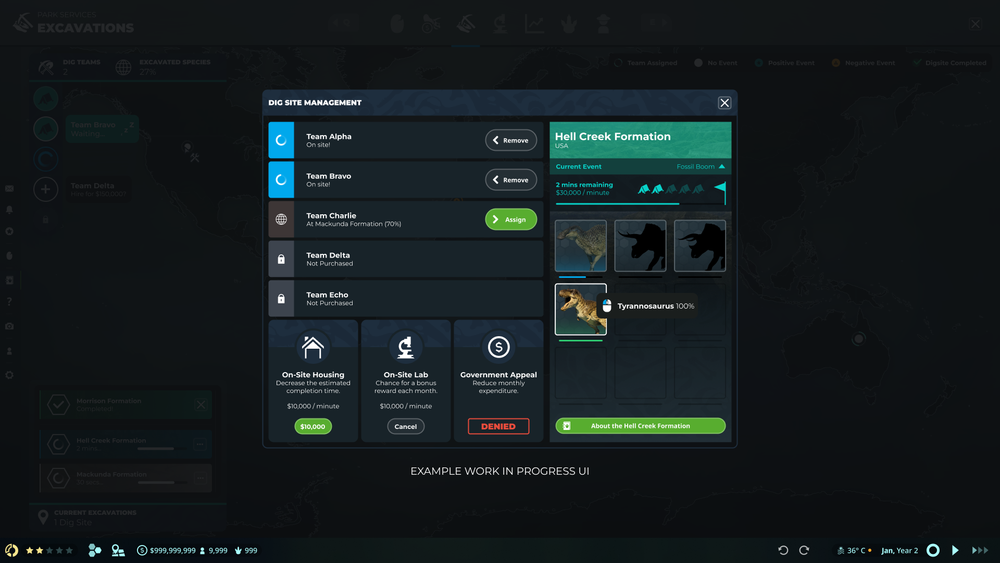
Each excavation cycle, your assigned teams will send their findings back to the park in the form of DNA.
The yield amount for DNA is random, but can be improved by installing infrastructure at the dig site such as housing (decreases total excavation time) and their own personal genetics lab (improves DNA yield amounts).
Different species have their own yield rarities, so even if you decide to tackle Hell Creek from day one, you’re unlikely to unlock a Tyrannosaurus before Edmontosaurus. Once 100% of the DNA has been found for a species, it can be bred from the Animal Nursery!
Completing all animals within a dig site will unassign the relevant teams and return them to the park.
EVENTS
Everything we’ve discussed so far assumes that your excavation has gone smoothly, though! Every month, there are global events that randomly impact dig sites all across the globe.
A positive event like the Fossil Boom can help speed up the excavation process, drastically increasing yield amounts for as long as the event is active in a dig site. On the other hand, a negative event like High Export Tax can increase your operating costs, excavation time and lower yields as your teams struggle to send your excavated goods back to the park.


Players may need to pivot their excavations from month to month depending on how these conditions change, taking advantage of sudden opportunities or temporarily leaving a site behind. What might have been a great month in the Hell Creek Formation may quickly turn to an expensive crawl the next!
Guest Art Overhaul
Moving into a more stylized art direction, the future brings a new era of visitors to Prehistoric Kingdom; intended to introduce better faces, hairs, clothing, new ethnicities and an expressive suite of animations that make the park feel more alive.

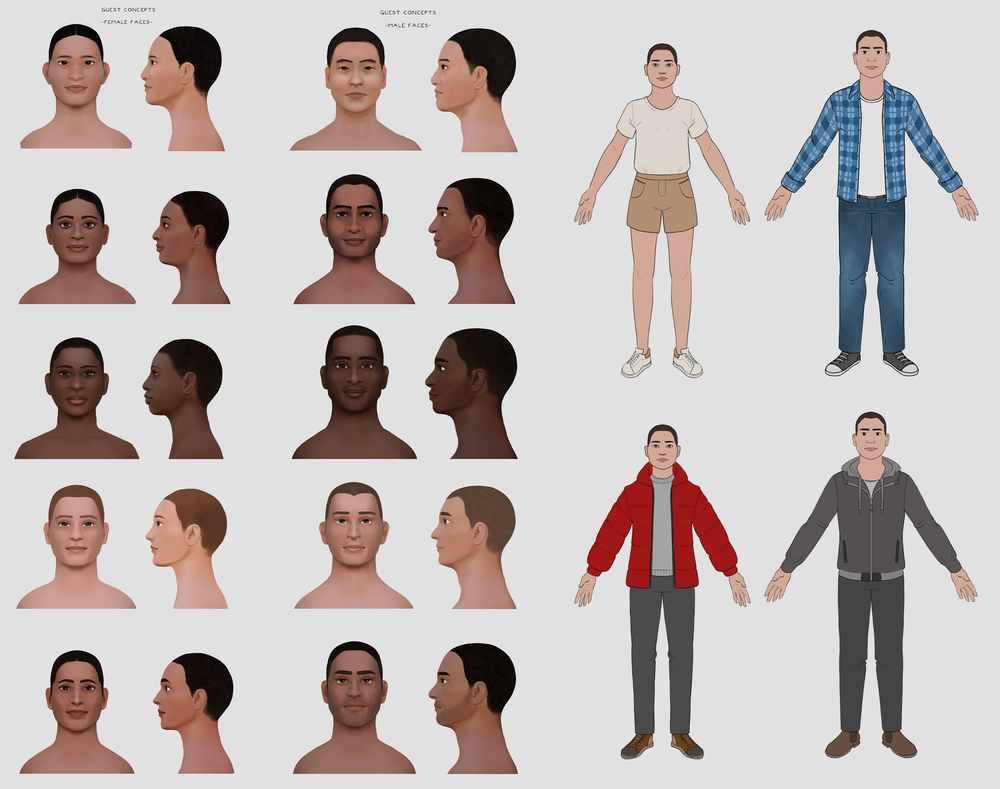
Below you can see some of the work in progress animations we’ve been making. Though not all will be in-game as of Update 11 (there are some technical things required to make the selfie work!) we hope this shows our commitment to improving the quality of our humans.
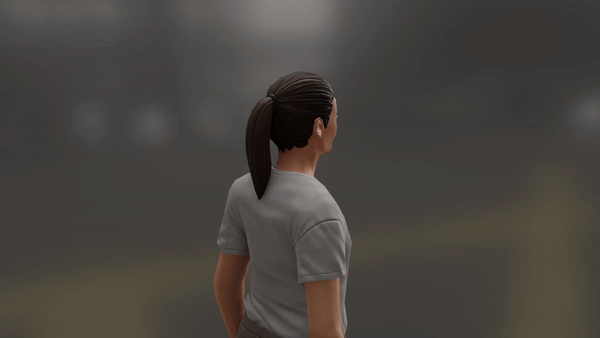
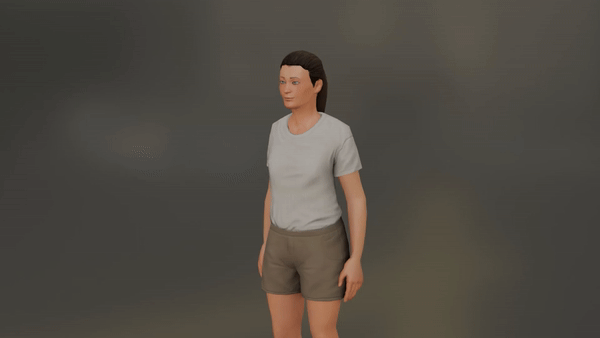

Mesh topology is non-final, we’ll be improving those elbows!
Update 11 is planned to bring the first stage of this guest art overhaul with it, focused on upgrading our technical backend to support these new visual features. There have been a lot of assets to design, model and curate, but we are getting there! We will have more info about what guest features are ready for Update 11 once it hits PTB.
And yes… we’re working on bench sitting!
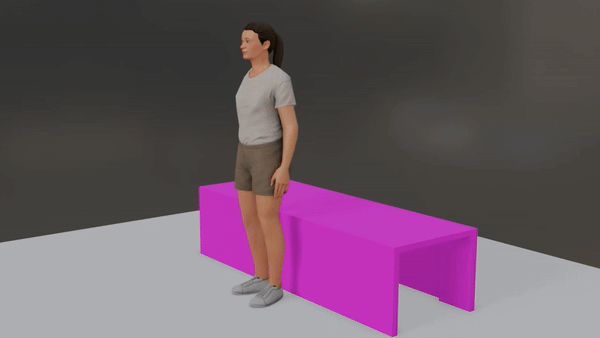
The Future
Ontogeny Art Tests
To close out this month’s Dev Diary, we’ll leave you with a work in progress look at our baby Tyrannosaurus! We’re expecting some proportions and face shapes to change before ontogeny is fully implemented and added to the public game, but this at least gives you an early look at how these fluff balls could look. You can even spot an adolescent T. rex in the back based on the Jane specimen!

As mentioned previously, all baby skins are designed to blend into their adult coloration regardless of what skin was selected. In the case of our T. rex here, that means all Tyrannosaurs would start as feathered infants and either lose feathers through maturation (e.g. growing up into a scaly skin) or retain them (e.g. growing up into the feathered skin). We can’t wait to share more looks at ontogeny with you in the future!
EDIT: Here’s an additional look at the baby rex with improved proportions! Since ontogeny in Prehistoric Kingdom is seamless, infant animals cannot have perfect 1:1 limb sizes to what’s found in the fossil record. We will be doing our best to make the babies feel cute and somewhat accurate without overly warping the models!
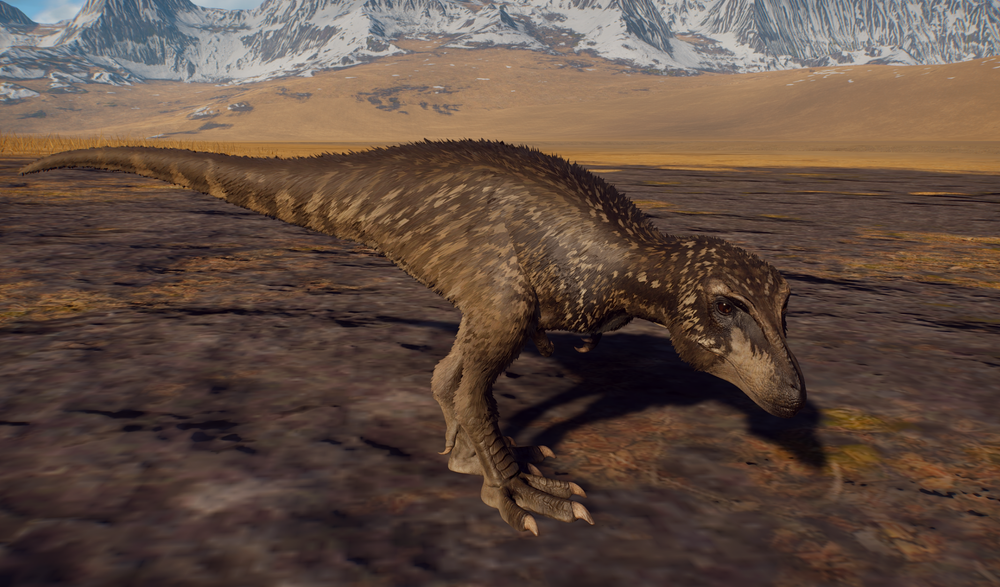


Created by Incog

Created by ASSASSINSPINO

Created by CarlosG72
Thank you for reading March’s dev diary!
There was a lot to read this month, but we hope you got through it okay! We’re very excited to continue developing Update 11 and can’t wait to share more once the PTB version goes live.
- The PK Team




